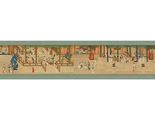18.5cm x 220cm in size.
Spring Morning in the Han Palace (Chinese: ?????) is a celebrated traditional Chinese painting from the Ming Dynasty (1368–1644 CE). Revered as a masterpiece of genre and courtly life painting, it vividly depicts the daily routines, leisure activities, and elegant ambiance of the imperial palace during the spring season.
Basic Information
Artist: Attributed to Qiu Ying (??), one of the "Four Masters of the Ming Dynasty," renowned for his meticulous brushwork and ability to revive classical themes with precision and grace.
Era: Mid-Ming Dynasty (approximately the 16th century CE).
Medium: Color and ink on silk.
Dimensions: Approximately 30.6 cm in height and 574.1 cm in width, forming a long horizontal handscroll.
Current Location: Housed in the National Palace Museum in Taipei, Taiwan, where it is cherished as a cornerstone of Chinese art collections.
Description of the Painting
The scroll unfolds as a panoramic narrative of life within an imperial palace, bustling with over 110 figures, including concubines, ladies-in-waiting, children, eunuchs, and scholars. The scene is set against lush spring landscapes—verdant gardens, blooming flowers, winding corridors, and traditional pavilions—creating a harmonious blend of human activity and natural beauty. Key elements include:
Central Scenes:
Ladies engaged in leisurely pursuits: playing musical instruments (qin and pipa), practicing calligraphy, admiring flowers, or tending to children.
Servants performing daily tasks: carrying water, arranging ornaments, or preparing tea.
Scholars conversing or reading in quiet pavilions, reflecting the cultural refinement of the court.
Artistic Style:
Qiu Ying’s meticulous brushwork (gongbi ??) brings intricate details to life, from the delicate patterns on silk robes to the texture of rocks and foliage.
Soft, pastel colors dominate the palette, evoking the freshness of spring, while architectural elements (e.g., lattice windows, stone bridges) are rendered with precise perspective.
The composition balances density and openness: crowded groups of figures contrast with airy garden spaces, guiding the viewer’s eye through the scroll.
Cultural and Historical Significance
Depiction of Imperial Life:
The painting offers a romanticized yet detailed glimpse into the opulent and structured world of the Ming Dynasty court. While not a literal historical record, it reflects contemporary ideals of elegance, hierarchy, and the leisurely lifestyle of the elite.
Symbolism of Spring:
Spring in Chinese art often symbolizes renewal, prosperity, and fertility. The vibrant garden scenes and active figures in Spring Morning embody these themes, linking imperial life to natural cycles and seasonal harmony.
Genre Painting Innovation:
Qiu Ying’s work elevates genre painting (focused on everyday life) to a sophisticated art form. By combining portraiture, landscape, and narrative, he creates a dynamic tableau that celebrates both human interaction and aesthetic refinement.
Legacy and Influence
Artistic Impact:
The scroll became a model for later courtly and genre paintings, influencing artists of the Qing Dynasty (1644–1912) and beyond. Its emphasis on detail and compositional balance inspired works in the gongbi style.
Cultural Legacy:
Spring Morning in the Han Palace is not only an artistic treasure but also a cultural touchstone, referenced in literature, film, and modern media to evoke the glamour and mystery of ancient Chinese imperial courts.
Historical Context:
The use of "Han Palace" in the title is symbolic, as the painting depicts a Ming Dynasty setting rather than the actual Han Dynasty (202 BCE–220 CE). This reflects a common Ming artistic trend of invoking classical themes to legitimize contemporary culture.
Appreciation and Critique
Scholars praise Qiu Ying’s technical mastery, noting how he captures the subtleties of human emotion—from the serene expressions of concubines to the busy energy of servants. The painting’s grand scale and intricate storytelling make it a landmark in Chinese narrative art, bridging the gap between realism and idealization.
In summary, Spring Morning in the Han Palace stands as a testament to the Ming Dynasty’s artistic sophistication, offering viewers a timeless window into the beauty and complexity of life within the imperial realm.
